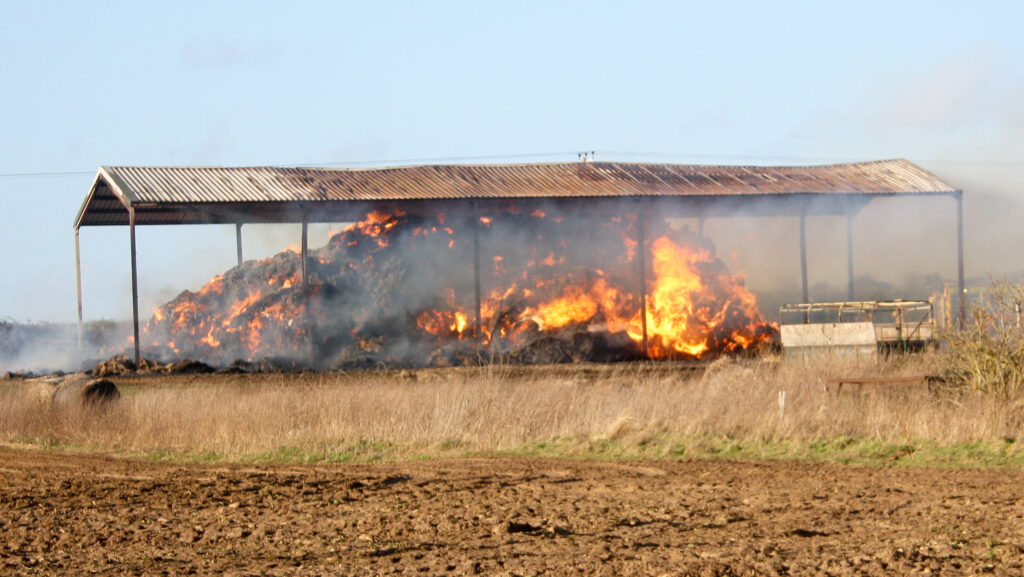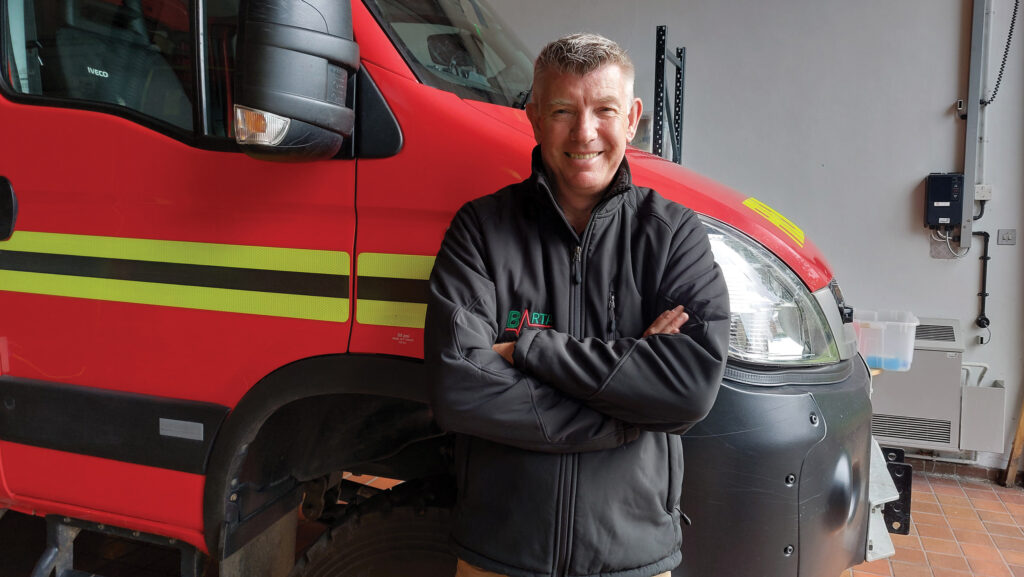Fire risk planning – what to consider on a livestock farm
 © AdobeStock
© AdobeStock Climate change is driving livestock farmers to consider farm resilience and feed security.
But it should also make them think about the increasing challenge from wildfires and the risk to their farm business operation.
Weather patterns are creating more prolonged dry, sunny conditions, and farm management is producing lots more dry vegetation, so wildfires seem inevitable.
There were 114 in the UK this year, according to the Global Wildfire Information System – compared with just 76 in 2012.
See also: Farmers praised for crucial moorland wildfire efforts
Furthermore, arson was one of the main causes of farm fire insurance claims in 2023 (alongside electrical faults and lightning strikes), according to the NFU Mutual.
With such statistics, firefighter Jim Green, of the British Animal Rescue and Trauma Care Association (known as Barta) in Hampshire, says livestock farmers cannot afford to ignore fire planning.
“Arson is always an issue, but climate change provides conditions that have not been on this scale before,” he points out.
Jim trains vets and non-animal professionals (such as the fire brigade) in how to handle large animals in emergency situations.
He says that as the risk of wildfires grows, it could result in multiple livestock farms in an area being affected.
This will tie up local hauliers and emergency services, making evacuation planning harder.

Jim Green, British Animal Rescue and Trauma Care Association © MAG/Shirley Macmillan
Safe emergency routes for livestock
Jim says the focus in fire emergency plans for farms tends to be on human safety, without considering animals – let alone herds or flocks of them.
Evacuation is a key consideration in fire planning, as sometimes animals are best to stay put, provided they are not downwind of fire.
“When fire alarms go off in a public building, we follow the exit signs to the muster station.
“Animals can’t help themselves, so we need to make plans for them.
“If a fire breaks out when there are 300 cows in the collecting yard, how are so many cows to be moved when they are in their routine of milking?” he says.
“You have to decide where they will go and make sure you do it in a controlled manner.
“The last thing you need is animals running round a yard willy-nilly and colliding with engines and people.
“Plan a safe route, with gates and races, that can be set up and done calmly.”
Most people tend to be reactive about fire instead of thinking ahead about potential problems and possible solutions. But Jim says it is essential for livestock farmers.
“Don’t wait until a fire happens before considering it a possibility: take fire planning seriously.
“If farmers are proactive and plan, it’s more likely they can survive a bigger event – and support their neighbours.”
Fire risk appraisal and plan
The starting point is to contact the farm’s insurer to arrange a visit from a fire risk assessor to have a fire risk appraisal, understand what is required, then create a fire plan.
This will cover areas from hazards, people at risk (staff and family workers), records and training, to evacuation plans and reviews.
The plan should also consider business continuity, says Jim – what will be needed to keep farming the day after a fire?
If the dairy is out of action, for instance, how are cows to be milked?
When stock have to be evacuated, what biosecurity measures and disease control are necessary?
Fire community risk register
Animal welfare is not included in local authority emergency planning, says Jim Green of the British Animal Rescue and Trauma Care Association.
He thinks the impact of fire is going to increase and says animal professionals need to be involved alongside the fire brigade, coastguard, Red Cross, and other agencies.
“The rural community is good at supporting each other.
“But this is not an isolated problem, and we will see more examples happening – and on a wider scale in a geographical area.
“So we need to build a regional list of collaborators,” he says.
Jim suggests a community asset register comprising local contacts such as farm vets, livestock hauliers, slaughtermen, and livestock markets.
Emergency control rooms can then use this resource to ensure that the right people with livestock experience and skills attend an emergency.
Furthermore, farmers should be included on a central register: those with available bowsers, livestock transport, cultivators, or a generator to get the parlour up for milking in a big emergency, he adds.
Local fire service visit
To help the emergency services to prioritise human safety, animal safety and operational effectiveness, Jim recommends asking the local fire service to visit.
This allows them to familiarise themselves with the farm’s specific challenges.
Firefighters have to understand a complex livestock farm site as quickly as possible, he says.
When they know they would need a fire rescue animal safety team, they can log that information centrally and understand the associated risks.
“For instance, if there is only one entry to your farm, this could get clogged up by 12 fire engines, yet you might still need to evacuate cattle,” he explains.
“Do the fire brigade know where to go? Use what3words to get them there.
“Have a map of the farm site readily available showing predetermined refuge areas, roads, entry/exit points and water sources.
“Also highlight high risks such as diesel tanks or slurry pits, or high voltage powerlines, which are a risk for jets of water.”
Livestock checks after a fire
Fires have a devastating effect on everyone, yet Jim thinks the aftermath is often underestimated: mental health challenges, restocking, biosecurity reassessments.
Aside from a huge clean-up operation, anything subjected to smoke is contaminated.
Smoke and soot have carcinogenic properties, so fire crews bag up their clothing before they return to the station and follow specific showering procedures.
“It means we have got to think of animal decontamination at some point, as they will try to self-clean their fur – we can’t walk livestock through a shower,” he says.
“Ask for your vet’s input. They will need to do welfare checks, immediately afterwards, for post-fire trauma and smoke inhalation.
“Burning embers can fall on a cow and burn without it being noticed.
“Farmers need to be proactive about fire. Have a fire risk assessment, and a fire plan. You can’t afford to ignore it.”
Fire prevention steps
As well as devising fire emergency plans, farm owners should also focus on preventing fires.
Not only is everything flammable, but a farmyard easily spreads fire: radiant heat causes neighbouring buildings to ignite; embers rise in the smoke plume to land on dry grass or crops.
“Look at what could cause a fire on your farm and reduce the chances of one starting,” says Jim Green of the British Animal Rescue and Trauma Care Association.
Farmyard infrastructure may be “positioned for convenience, not an emergency” but, ideally, it should compartmentalise.
Anything that can potentially start a fire – or fuel one – should be kept separate from livestock and flammable materials, such as hay, or exploding ones such as fertiliser.
“Separate things you want to save and take storage advice seriously for flammables and explosive chemicals.
“Don’t store lots of old material such as tyres or oxyacetylene cylinders – they can go off like a bomb in a building,” he explains.
Fire breaks
“Don’t park tractors – or the telehandler – in the straw shed, for instance, as they will be needed to make a fire break in fields to control fire and minimise damage.
“Vegetation also gives off a lot of smoke; visibility is quickly reduced and you get disoriented, so limit this happening and limit the spread of fire. Don’t make it worse than it is.”
Electrical faults are still a major cause of farm fires, though LED lighting is much safer than traditional strip lighting and halogen bulbs, says Jim.
A farm should have a modern system – “don’t keep adding to old electrics” – protected from vermin and checked regularly.
“Get electrics checked; they need PAT [portable appliance testing], and don’t overload extension leads – check fuse ratings,” he adds.

